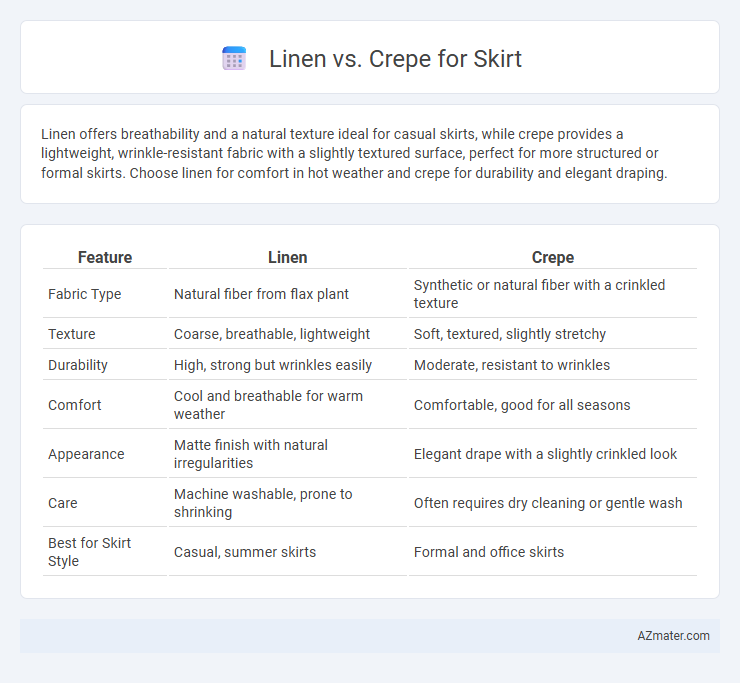Linen offers breathability and a natural texture ideal for casual skirts, while crepe provides a lightweight, wrinkle-resistant fabric with a slightly textured surface, perfect for more structured or formal skirts. Choose linen for comfort in hot weather and crepe for durability and elegant draping.
Table of Comparison
| Feature | Linen | Crepe |
|---|---|---|
| Fabric Type | Natural fiber from flax plant | Synthetic or natural fiber with a crinkled texture |
| Texture | Coarse, breathable, lightweight | Soft, textured, slightly stretchy |
| Durability | High, strong but wrinkles easily | Moderate, resistant to wrinkles |
| Comfort | Cool and breathable for warm weather | Comfortable, good for all seasons |
| Appearance | Matte finish with natural irregularities | Elegant drape with a slightly crinkled look |
| Care | Machine washable, prone to shrinking | Often requires dry cleaning or gentle wash |
| Best for Skirt Style | Casual, summer skirts | Formal and office skirts |
Overview of Linen and Crepe Fabrics
Linen fabric, derived from flax fibers, is renowned for its breathability, moisture-wicking properties, and natural texture, making it ideal for warm-weather skirts. Crepe fabric, typically made from silk, wool, or synthetic fibers, features a distinctive crinkled surface that provides drape, elegance, and stretch, suited for more structured or formal skirts. Both fabrics offer unique advantages in terms of comfort and appearance, with linen excelling in casual wear and crepe favored for refined, polished looks.
Key Differences Between Linen and Crepe
Linen skirts offer breathability, natural texture, and moisture-wicking properties ideal for warm weather, while crepe skirts provide a smooth, slightly crinkled appearance with excellent drape and wrinkle resistance. Linen fibers are derived from the flax plant, resulting in a lightweight, durable fabric that softens with washing, whereas crepe is typically made from silk, wool, or synthetic fibers featuring a textured surface created through a unique weaving technique. Choosing between linen and crepe for skirts depends on desired comfort, seasonality, and the balance between casual and formal aesthetics.
Comfort and Breathability in Skirt Fabrics
Linen skirts excel in comfort and breathability due to their natural fibers that allow air circulation and moisture-wicking, making them ideal for warm weather. Crepe skirts offer a slight stretch and textured surface that enhances comfort but may not be as breathable as linen. When prioritizing airflow and cooling, linen remains the superior fabric choice for skirts designed for all-day wear in hot climates.
Texture and Appearance: Linen vs Crepe
Linen fabric features a slightly coarse texture with natural slubs, giving skirts a casual, breathable, and textured appearance ideal for warm weather. Crepe, made from tightly twisted fibers, offers a smooth yet crinkled surface that reflects light subtly, creating an elegant and flowing silhouette. The crisp, matte finish of linen contrasts sharply with crepe's fluid drape and slightly textured sheen, making each fabric suitable for distinct style preferences and occasions.
Durability and Longevity Comparison
Linen skirts are known for their natural strength and breathability but tend to wrinkle easily and may weaken with frequent washing, affecting long-term durability. Crepe fabric offers superior resilience with its tightly woven texture, providing better resistance to wear and tear and maintaining shape over time. Choosing crepe enhances skirt longevity due to its wrinkle resistance and durability, making it ideal for everyday use.
Suitability for Different Skirt Styles
Linen offers a crisp, breathable texture ideal for A-line and pencil skirts, providing structure and cool comfort in warm weather. Crepe's slightly textured, drapey fabric suits pleated and wrap skirts, enhancing fluid movement and elegance. Both fabrics complement different skirt styles by balancing formality and comfort, making them versatile choices based on design and occasion.
Maintenance and Care Requirements
Linen skirts require gentle washing in cold water and should be air-dried to prevent shrinking and maintain fabric integrity. Crepe skirts need delicate hand washing or dry cleaning to preserve their textured surface and avoid fabric distortion. Both fabrics benefit from storing folded rather than hanging to reduce stretching, but linen is more prone to wrinkles and may need frequent ironing while crepe resists creasing better.
Seasonal Adaptability: Linen vs Crepe
Linen skirts excel in breathability and moisture-wicking properties, making them ideal for hot summer months and warm climates. Crepe skirts offer better insulation and wrinkle resistance, providing comfort and style in cooler seasons or transitional weather. Choosing between linen and crepe depends on the seasonal adaptability needed, with linen suited for summer and crepe favored for autumn and spring wardrobes.
Price Point and Accessibility
Linen skirts tend to be more affordable due to the widespread availability of flax fibers and simpler manufacturing processes, making them accessible in most markets. Crepe skirts, often crafted from silk or polyester blends, usually come at a higher price point due to their intricate weaving techniques and luxury appeal. Both materials vary in accessibility depending on regional textile industries, but linen generally offers a budget-friendly option with easy procurement.
Choosing the Best Fabric for Your Skirt
Linen offers breathability, moisture-wicking properties, and a natural texture ideal for summer skirts, providing comfort in hot climates. Crepe fabric features a distinctive crinkled texture, excellent drape, and wrinkle resistance, making it suitable for elegant, structured skirts and all-season wear. Choosing between linen and crepe depends on your desired skirt style, climate, and maintenance preference, with linen perfect for casual, airy skirts and crepe better for polished, durable garments.

Infographic: Linen vs Crepe for Skirt
 azmater.com
azmater.com